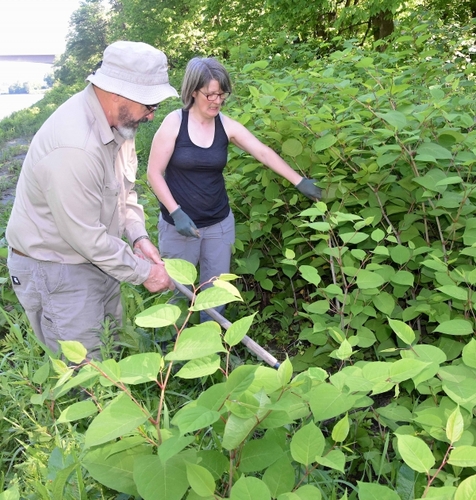BRATTLEBORO — On a section of riverbank on the edge of West River Park, the Conservation Commission is doing its best to try to control the spread of Japanese knotweed.
The swimming hole and paddle-powered boat launch on the West River, a popular spot for visitors in the summer, is completely surrounded by knotweed.
Town Planning Director Sue Fillion said that, left to its own devices, the patch of Japanese knotweed would grow to be very dense and impede public access to the river.
So the Conservation Commission plans a series of work sessions to cut back the overgrowth, and its members are looking for volunteers to help them.
One of those sessions was held on June 6, one of the rare sunny and dry days in Brattleboro this spring. Fillion, members of the commission, and a couple of volunteers used loppers and pruners to chop down the knotweed.
While some communities use chemicals to kill knotweed, Brattleboro is using the non-chemical method: chopping down the plant, leaving just a stub.
“The idea is to cut them while they're about knee high,” said Fillion. “That's why we need volunteers.”
Aggressive measures for an aggressive plant
Conservation Commission member Jennifer Latham said that two-thirds of a Japanese knotweed (Fallopia japonica) plant is its deep root system. Chopping back the plant in the spring, before it has a chance to grow too big, will starve the roots and eventually kill the plant.
And one cutting is not enough. The plants can grow about 3 inches a day during the spring and summer, and grow up to10 feet tall with stalks about 1 inch in diameter.
Plant fragments can easily re-sprout into new plants, which makes composting the cuttings out of the question. Fillion said the best way to dispose of Japanese knotweed is to pile the cut plants onto a wooden pallet, cover them with a tarp so they dry out, and then burn them in the fall.
Last year, Latham and the commission put together a series of three short instructional videos for Brattleboro Community Television that look at why the plant is a threat, how to identify it, and how to control its growth without chemicals.
The videos, produced by Latham, can be found at brattleborotv.org/brattleboro-conservation-commission. They recently won a Hometown Media Award in the Instructional and Training category from the national organization, Alliance for Community Media.
“We were surprised at the amount of interest in our videos,” Latham said. The identification video had more than 35,000 views on YouTube.
Given the persistent nature of knotweed, Fillion said there will be plenty for volunteers to do over the next few months.
The stalks will need to be cut back at least once a month during the growing season, and it might take several years before the river bank below West River Park is knotweed-free.
'Basically, it's a bully'
How did these plants get to be such a problem?
According to vtinvasives.org, a joint communications effort of a number of state and federal agencies and educational institutions, invasive species are “plants, insects, and other organisms that were either accidentally or intentionally introduced from other places that cause harm to the things we value.”
Once they establish themselves, invasive species “can negatively impact agriculture, recreation, forestry, human health, the environment, and the economy,” the site explains.
Japanese knotweed was first brought to the United States for ornamental use in the late 1800s. It is a large herbaceous plant with smooth, hollow, and jointed stems that make it look similar to bamboo.
It is one of the 39 species on the Vermont Noxious Weed Quarantine list, and it is illegal to purchase, plant, or transport this plant in the state.
Japanese knotweed mostly can be found on river banks, roadsides, and the edges of forest land. Because of its speedy growth, it usually crowds out native vegetation and increases riverbank erosion, since the ground beneath a dense growth of knotweed cannot support other vegetation.
“Basically, it's a bully,” said Latham.
